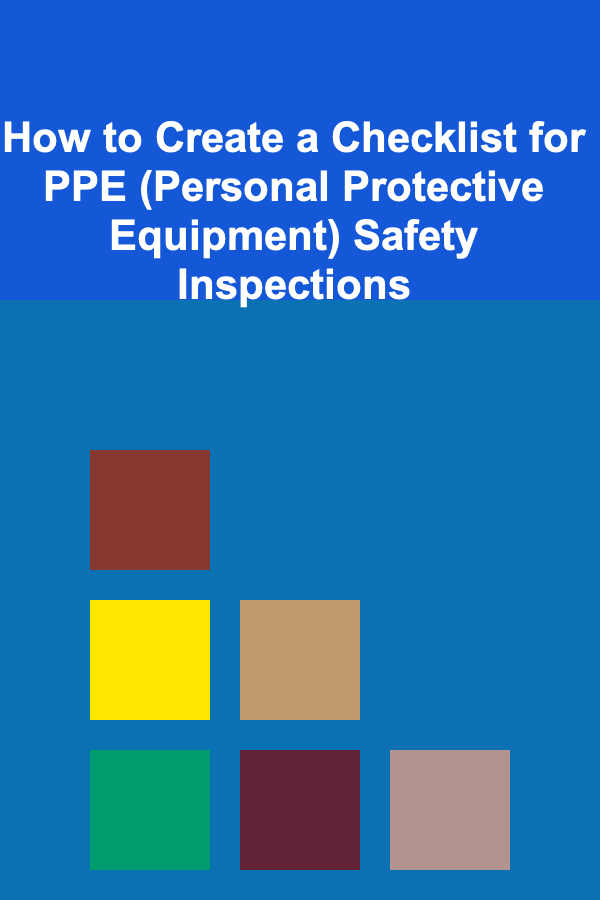
How to Create a Checklist for PPE (Personal Protective Equipment) Safety Inspections
ebook include PDF & Audio bundle (Micro Guide)
$12.99$9.99
Limited Time Offer! Order within the next:

Personal Protective Equipment (PPE) is essential in ensuring the safety and well-being of workers, particularly in high-risk environments. Whether you're managing a construction site, a laboratory, a manufacturing plant, or any other workplace where hazards are present, PPE helps mitigate the risks of injury or illness. However, PPE is only effective if it is used properly and regularly inspected for wear and tear.
This guide will walk you through the process of creating a thorough checklist for PPE safety inspections. It will highlight the critical components to include, best practices for conducting inspections, and how to ensure compliance and effectiveness in your workplace safety programs.
Understanding the Importance of PPE Inspections
Before delving into the creation of a PPE inspection checklist, it's crucial to understand why these inspections are so important. PPE serves as the last line of defense between workers and potential hazards. Regular inspections ensure that PPE is functional, properly maintained, and fit for use. The failure to conduct these inspections can lead to:
- Increased risk of injury or illness: Worn-out or faulty PPE cannot provide the level of protection needed, exposing workers to dangers.
- Legal and regulatory consequences: Many workplace safety regulations require that PPE be inspected regularly. Non-compliance can lead to penalties, fines, or legal action.
- Financial costs: The absence of proper inspections can result in costly accidents, medical expenses, and worker compensation claims.
- Reduced worker morale: Employees who do not feel safe at work may have lower morale, which could affect productivity and retention.
Key Components of PPE
Before creating your checklist, it's essential to understand the various types of PPE that might require inspection in your workplace. PPE comes in many forms, and each type has specific elements that need to be checked regularly:
- Head Protection (e.g., hard hats, helmets)
- Eye and Face Protection (e.g., goggles, face shields)
- Hearing Protection (e.g., earplugs, earmuffs)
- Respiratory Protection (e.g., masks, respirators)
- Hand Protection (e.g., gloves)
- Foot Protection (e.g., safety boots, shoes)
- Body Protection (e.g., aprons, vests, full-body suits)
- Fall Protection (e.g., harnesses, lanyards)
- Protective Clothing (e.g., chemical-resistant suits)
Each type of PPE will require unique checks for different criteria, but all must be thoroughly assessed for their functionality, safety, and comfort.
Step 1: Identify PPE Requirements for Your Workplace
Every workplace has different risks, which means the types of PPE required will vary. It's essential first to identify the hazards in your work environment so that you can determine the necessary PPE for each task. For example:
- In a construction site, hard hats, gloves, safety boots, and high-visibility vests are critical.
- In a laboratory, gloves, goggles, face shields, and respiratory protection may be necessary.
- In a manufacturing facility, hearing protection, safety shoes, and protective clothing may be required.
Consult with safety experts, employees, and any relevant safety regulations or standards (e.g., OSHA, ANSI) to ensure that all required PPE is available.
Step 2: Develop Specific Criteria for Inspection
Each piece of PPE must be inspected based on specific criteria. This can include checking for signs of damage, proper fit, and cleanliness. Here are some of the most common criteria to include in your checklist:
1. Condition and Integrity
- Hard Hats: Check for cracks, dents, or wear. Ensure the suspension system is intact and properly adjusted.
- Gloves: Inspect for holes, cuts, or significant wear. Ensure that they are free from contaminants (such as chemicals or oils).
- Respirators: Examine the seals, valves, straps, and filters. Make sure they are clean and free from damage.
- Footwear: Check for holes, worn-out soles, or damage to the toe caps. Ensure the footwear provides adequate support and traction.
- Eye and Face Protection: Inspect for cracks or scratches on lenses. Ensure face shields are clear and free of fog, and the straps are in good condition.
2. Proper Fit
- PPE that does not fit properly will fail to provide the intended protection. Check for:
- Correct sizing for headgear, gloves, and footwear.
- Proper adjustment of straps and closures to ensure a snug, secure fit.
3. Cleanliness and Hygiene
- PPE should be kept clean to avoid contamination or discomfort. Make sure that items like gloves, masks, or boots are clean and dry before use.
- For respiratory protection, ensure that filters and cartridges are free from dust, dirt, or chemicals that could impair performance.
4. Functionality and Performance
- Verify that PPE functions as intended. For example:
- Hard hats should stay securely in place when worn.
- Respirators should provide a tight seal without leakage.
- Hearing protection should block out harmful noise levels without causing discomfort.
5. Expiration Dates and Maintenance Schedules
- Some PPE, especially respiratory protection, has a limited lifespan. Make sure to check expiration dates or service life recommendations for items like filters, cartridges, and chemical suits.
- Include a maintenance schedule for any PPE that requires regular servicing (e.g., cleaning respirators, testing harnesses).
Step 3: Create a PPE Inspection Checklist Template
Now that you've identified the essential criteria for inspecting each type of PPE, it's time to create your checklist. A good PPE safety inspection checklist should be:
- Simple and Easy to Use: Keep the checklist concise and structured to make it easy for inspectors to follow.
- Comprehensive: Ensure that it covers all types of PPE, with space for inspectors to record the condition of each item.
- Action-Oriented: Include options for inspectors to indicate whether an item passes or fails, and provide space for corrective actions or notes.
Sample PPE Safety Inspection Checklist
| PPE Type | Inspection Criteria | Pass/Fail | Corrective Actions | Notes | |--------------------|-----------------------------------------------|-----------------------|---------------------------|---------------------------------| | Hard Hat | No cracks, dents, or damage to shell | [ ] Pass [ ] Fail | Replace if damaged | Check suspension system | | Gloves | No holes, cuts, or significant wear | [ ] Pass [ ] Fail | Replace if damaged | Ensure gloves are chemical-free | | Respirators | No damage to seals, valves, or filters | [ ] Pass [ ] Fail | Replace filters if needed | Ensure proper fit and seal | | Safety Boots | No holes, worn-out soles, or damaged toe caps | [ ] Pass [ ] Fail | Replace boots if needed | Check comfort and fit | | Safety Glasses | No cracks or scratches, clean lenses | [ ] Pass [ ] Fail | Replace if scratched | Ensure face shields are clear |
Step 4: Train Employees and Inspectors
Once the checklist is created, it's crucial to train employees and safety inspectors on how to conduct PPE inspections. Make sure they understand:
- The proper procedure for conducting inspections, including the frequency (e.g., daily, weekly, monthly).
- How to identify signs of wear, damage, and other issues that may affect PPE performance.
- The process for documenting findings, including how to report and address any failures or issues discovered during inspections.
It's also a good idea to conduct mock inspections and provide feedback to ensure that everyone is confident and capable of performing thorough checks.
Step 5: Review and Improve the Checklist Regularly
PPE safety is an ongoing process, and your inspection checklist should evolve to meet changing workplace conditions and regulatory requirements. Make sure to:
- Regularly review the checklist and adjust it based on feedback from employees and inspectors.
- Stay updated with industry best practices and regulatory changes.
- Adjust for new types of PPE if your workplace's needs change.
Conclusion
A well-constructed PPE safety inspection checklist is a vital tool for maintaining workplace safety and ensuring that personal protective equipment functions as intended. By creating a detailed and actionable checklist, conducting regular inspections, and providing proper training, you can significantly reduce the risk of injury and ensure compliance with safety regulations. The ultimate goal is to protect your workforce and foster a culture of safety that prioritizes both the well-being of your employees and the operational integrity of your business.
Reading More From Our Other Websites
- [Personal Finance Management 101] How to Plan for Healthcare Costs in Your Retirement
- [Home Soundproofing 101] How to Choose the Right Professional Soundproofing Services
- [Home Family Activity 101] How to Host Get Together Games for Family Reunions
- [Star Gazing Tip 101] Seasonal Sky Maps: When and Where to Photograph the Milky Way Year-Round
- [Home Space Saving 101] How to Make Your Small Kitchen Feel Bigger with Clever Tips
- [Organization Tip 101] Why Organizing Kitchen Utensils Saves Time When Cooking
- [Simple Life Tip 101] Best Simple‑Life Financial Apps That Automate Savings Without Hassle
- [Personal Financial Planning 101] How to Build an Emergency Fund and Why It's Important
- [Personal Care Tips 101] How to Overcome a Weight Loss Plateau
- [Organization Tip 101] How to Organize Your Laundry Room for Kids' Clothing

How to Create a Supply Rotation System for New Items
Read More
How to Maximize Space in a Tiny Apartment
Read More
How to Optimize Your Home's Layout for Better Space Efficiency
Read More
How To Sketch Food and Culinary Art: A Comprehensive Guide
Read More
How to Avoid Common Travel Scams: A Comprehensive Guide
Read More
10 Tips for Designing a Minimalist Website That Converts
Read MoreOther Products

How to Create a Supply Rotation System for New Items
Read More
How to Maximize Space in a Tiny Apartment
Read More
How to Optimize Your Home's Layout for Better Space Efficiency
Read More
How To Sketch Food and Culinary Art: A Comprehensive Guide
Read More
How to Avoid Common Travel Scams: A Comprehensive Guide
Read More